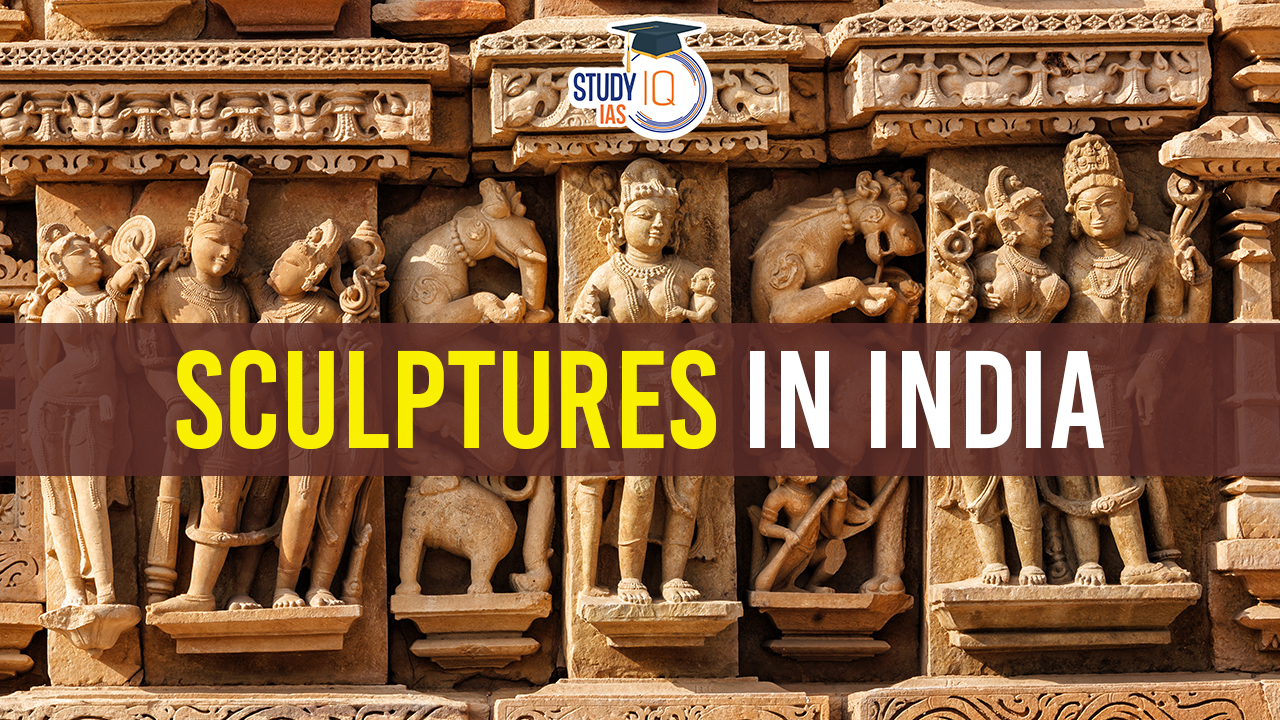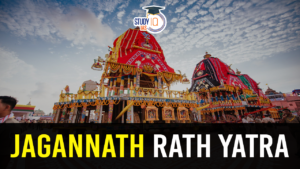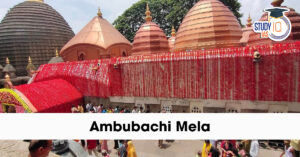Table of Contents
India boasts a diverse sculpture tradition, spanning millennia. From the ancient terracotta figurines of the Indus Valley Civilization to the iconic Lion Capital of Ashoka from the Maurya period, and the intricate carvings of the Chola temples, Indian sculpture reflects a rich cultural tapestry. The sensuous sculptures of Khajuraho, the detailed reliefs of Hampi’s Virupaksha Temple, and contemporary works by artists like Ramkinkar Baij contribute to this vibrant heritage, showcasing the evolution of artistic expression across different periods and regions.
We’re now on WhatsApp. Click to Join
Sculptures in India
India has a rich and diverse tradition of sculpture that spans thousands of years, reflecting the country’s cultural, religious, and artistic heritage. Here are some notable examples and styles of sculptures in India:
| Period | Highlights |
| Indus Valley Civilization | Earliest sculptures include small terracotta figurines, seals, and depictions of human and animal forms. |
| Maurya and Sunga Period | The Maurya Empire’s Lion Capital of Ashoka at Sarnath, characterized by four lions standing back to back, is a national emblem. |
| Gupta Period | Considered the “Golden Age” of Indian art, this era produced exquisite temple sculptures, exemplified by the caves of Ajanta and Ellora. |
| Chola Dynasty | Prolific temple builders, Cholas adorned temples in South India with intricate sculptures. The Brihadeshwara Temple in Thanjavur is a prime example. |
| Khajuraho Monuments | Famous for intricately carved sculptures depicting various life aspects, including sensuous scenes. Renowned for Nagara-style architecture. |
| Hoysala Dynasty | Hoysala temples in Karnataka, like the Chennakesava Temple at Belur and Hoysaleswara Temple at Halebid, showcase finely carved sculptures of Hindu mythology. |
| Vijayanagara Empire | The Virupaksha Temple at Hampi, a UNESCO World Heritage Site, is known for impressive sculptures representing gods, goddesses, and mythological creatures. |
| Mughal Period | Notable for intricate marble inlay work and relief carvings, seen in structures like the Taj Mahal. |
| Colonial and Post-Independence | Modern sculptors like Ramkinkar Baij, Dhanraj Bhagat, and Meera Mukherjee contribute significantly to Indian sculpture. |
| Contemporary Sculpture Parks | Recent developments include sculpture parks like Madhavendra Palace Sculpture Park in Jaipur and Krishnakriti Foundation’s park in Hyderabad. |
Sculptures in India: Indus Valley Civilization
The Indus Valley Civilization (3300–1700 BCE) laid the foundation for Indian sculpture, showcasing remarkable artistic achievements. Although primarily known for its urban planning and advanced drainage systems, the civilization also produced distinctive sculptures.
Types of Sculptures
- Dancing Girl: Perhaps the most iconic artifact, the tiny bronze “Dancing Girl” reflects the civilization’s mastery of metalwork. The sculpture, with its poised posture and intricate details, exemplifies the artistic sophistication of the time.
- Seals: Indus Valley seals feature intricate carvings of animals, deities, and symbols. These seals, often made of steatite, served various purposes, including trade and administrative use.
- Terracotta Figurines: Small terracotta figurines depicting human and animal forms were prevalent. These sculptures, though modest in size, displayed a keen attention to detail and captured daily life aspects.
Artistic Characteristics
- Naturalism: Indus Valley sculptures demonstrated a keen observation of natural forms, portraying animals and humans with a high degree of realism.
- Symbolism: Many sculptures, especially seals, carried symbols that remain undeciphered, adding an element of mystery to the artistic expressions of the civilization.
- Functional Art: The artifacts, including sculptures, often had practical purposes, such as seals for trade and terracotta figurines for domestic use or religious rituals.
Sculptures in India: Maurya and Sunga Period
The Maurya and Sunga Periods mark a significant phase in Indian history, characterized by political stability, artistic flourishing, and the propagation of Buddhism. Sculptures from this era provide insights into the cultural and religious developments of the time.
Key Features
- Lion Capital of Ashoka: The Maurya Empire, under the reign of Emperor Ashoka, is renowned for the creation of the Lion Capital of Ashoka at Sarnath. This iconic sculpture, featuring four lions standing back to back, became the national emblem of India.
- Buddhist Art: The Mauryan and Sunga periods witnessed a notable proliferation of Buddhist art. Sculptures of Buddha, Bodhisattvas, and scenes from Buddha’s life adorned stupas and monastic complexes.
- Sculptural Diversity: Sculptures from this era display a diverse range of subjects, including royal patronage, religious themes, and depictions of daily life. The Mauryan Empire embraced both court-sponsored art and a popular style created by other artists.
Mauryan Period Sculpture
- Pillars: The Mauryan period is known for its monumental pillars, often inscribed with edicts and topped with elaborately carved capitals featuring animal motifs. The pillars served administrative and propagational purposes.
- Sarnath Rail: At Sarnath, a monolithic rail adorned with intricate carvings showcased the artistry of the period. The rail served as an architectural element in the religious landscape.
- Animal Sculptures: The abaci of the pillars were adorned with animal sculptures, reflecting a blend of naturalism and symbolic significance. These sculptures included elephants, lions, and other fauna.
Yakshini Sculptures
Yakshini at Didarganj: The Mauryan period saw the creation of impressive Yakshini sculptures. The Yakshini at Didarganj, now housed in the Patna Museum, is a notable example, showcasing the grace and elegance characteristic of Mauryan art.
Sculptures in India: Gupta Period
The Gupta Period (c. 320–550 CE) is often regarded as the “Golden Age” of Indian art, witnessing a flourishing of creative expression, particularly in sculpture. This era marked a pinnacle in North Indian art, encompassing a diverse range of themes and styles.
Key Features
- Classic Pinnacle of Art: The Gupta art is recognized as a classic pinnacle and golden age for North Indian art. It saw the convergence of Hindu, Buddhist, and Jain artistic traditions.
- Religious Sculptures: Gupta sculptures prominently featured religious themes, depicting Hindu deities, Buddha, and Jain Tirthankaras. Temples and cave complexes became prominent canvases for these artistic expressions.
- Birth of Iconic Deities: The Gupta period saw the birth of iconic carved stone deities in Hindu art. Images of Vishnu, Shiva, and Devi started to take distinct forms, setting the precedent for future representations.
Hindu Art
- Vishnu: Gupta sculptures often portrayed Vishnu in various forms, emphasizing his divine attributes. The image of Vishnu as Vaikuntha Vishnu, with four arms and standing on a lotus, became particularly popular.
- Shiva: Sculptures of Shiva portrayed him in multiple forms, including the dancing Nataraja and the ascetic meditating form. These representations captured the dynamic and transcendent aspects of Shiva.
Jain and Buddhist Art
- Jain Tirthankaras: The Gupta period witnessed an increase in the sculptural representation of Jain Tirthankaras. These figures, adorned with symbols, displayed a sense of tranquility and spiritual enlightenment.
- Buddha: Buddha sculptures from this era continued to evolve, showcasing a serene and compassionate expression. The Buddha figures became more standardized, emphasizing the calm demeanor and teachings of the Enlightened One.
Ajanta Caves
- Exquisite Cave Paintings: While not exclusively sculptures, the Ajanta Caves exemplify Gupta artistic achievements. The cave walls adorned with paintings and sculptures depict scenes from Buddha’s life and the Jataka tales.
- Integration of Art and Architecture: The sculptures in the Ajanta Caves seamlessly integrated with the architectural elements, creating a holistic visual experience for the visitors.
Sculptures in India: Chola Dynasty
The Chola Dynasty, particularly during its peak from the 9th to the 13th centuries, witnessed an extraordinary development in temple architecture and sculpture. The Chola rulers, known for their patronage of the arts, left an indelible mark on the sculptural heritage of South India.
Key Features
- Prolific Temple Builders: The Cholas were prolific temple builders, and their reign is synonymous with the construction of grand temples adorned with intricate sculptures. These temples became the focal points of artistic and religious expression.
- Dravidian Architecture: Chola temples are exemplars of Dravidian architecture, characterized by towering vimanas, intricately carved gopurams (entrance towers), and extensive pillared halls. The sculptures adorned the exterior and interior of these architectural marvels.
- Bronze Casting: In addition to architectural sculptures, the Cholas are renowned for their bronze casting. The Chola period saw the creation of exquisite bronze sculptures of deities, especially during the Chola bronze age.
Prominent Temples
- Brihadeshwara Temple, Thanjavur: Commissioned by Raja Raja Chola I, this temple is a UNESCO World Heritage Site. Its towering vimana, adorned with sculptures, is a testament to Chola grandeur.
- Airavatesvara Temple, Darasuram: Built by Rajaraja Chola II, this temple is known for its intricately carved pillars and sculptures, showcasing the mastery of Chola artisans.
Intricate Sculptures
- Deities and Mythological Scenes: Chola sculptures depict Hindu deities such as Shiva, Vishnu, and Devi, capturing various aspects of their divine personas. Mythological scenes from epics like the Ramayana and Mahabharata are also common.
- Dancing Nataraja: The Chola period produced iconic sculptures of Lord Shiva in his cosmic dance form, Nataraja. These sculptures symbolize the rhythmic cycles of creation and destruction.
Contributions to Bronze Sculpture
- Chola Bronze Age: The Cholas played a pivotal role in the development of bronze casting techniques. Bronze sculptures of deities, characterized by graceful poses and intricate details, reached unparalleled heights during this era.
- Nataraja Bronzes: The Chola bronze Nataraja sculptures, in particular, are celebrated worldwide for their artistic and symbolic significance, portraying Shiva’s dance as the cosmic dancer.
Sculptures in India: Khajuraho Monuments
The Khajuraho Group of Monuments, built between 950 and 1050 CE, stands as a testament to the artistic brilliance of the Chandela dynasty. These temples, located in Madhya Pradesh, India, are renowned for their intricate sculptures, particularly depicting various aspects of life, including sensuous and erotic scenes.
Key Features
- Architectural Splendor: Khajuraho temples exhibit Nagara-style architecture, characterized by ornate spires (shikharas) and intricate carvings on the temple walls.
- Intricate Carvings: The temples boast thousands of sculptures portraying deities, celestial beings, mythical creatures, and daily life scenes. Notably, the erotic sculptures, while a small percentage of the overall artwork, are iconic.
Significance of Erotic Sculptures
- Artistic Expression: The erotic sculptures at Khajuraho are seen as a celebration of human sensuality and artistic expression. They showcase a nuanced understanding of the human form and intimate relationships.
- Symbolic Interpretations: Some scholars suggest symbolic interpretations, linking the erotic carvings to Tantric practices, fertility rituals, or representing the union of divine energies.
Prominent Temples
- Kandariya Mahadeva Temple: Dedicated to Lord Shiva, this temple is the largest at Khajuraho and features intricate carvings depicting gods, goddesses, and celestial maidens.
- Lakshmana Temple: Dedicated to Lord Vishnu, it is known for its captivating sculptures narrating episodes from the Ramayana.
Sculptures in India: Hoysala Dynasty
- Detailed Artistry: Hoysala temples in Karnataka, including Chennakesava Temple at Belur and Hoysaleswara Temple at Halebid, boast detailed and finely carved sculptures.
- Mythological Depictions: Sculptures vividly showcase scenes from Hindu mythology, with intricately carved figures and narrative panels adorning the temple exteriors.
- Innovative Architecture: Hoysala artisans introduced unique star-shaped platforms and intricate lathe-turned pillars, elevating their sculptures to architectural marvels.
Sculptures in India: Vijayanagara Empire
- Virupaksha Temple: Hampi’s UNESCO-listed Virupaksha Temple features impressive sculptures depicting gods, goddesses, and mythological creatures.
- Stupendous Stone Carvings: The Vijayanagara period is renowned for its monumental stone carvings, seen in the narrative reliefs and decorative motifs adorning temple walls.
- Religious Diversity: Sculptures in Vijayanagara art encompass diverse religious themes, reflecting the empire’s inclusive patronage of Hinduism and Virashaiva traditions.
Sculptures in India: Mughal Period
- Intricate Inlay Work: Mughal architecture, including the Taj Mahal, showcases sculptures with intricate marble inlay work and delicate relief carvings.
- Palatial Art: While renowned for architecture, Mughal sculptures adorn structures like the Red Fort, featuring depictions of animals, floral patterns, and calligraphy.
- Imperial Grandeur: Mughal rulers, including Akbar and Shah Jahan, patronized art, resulting in sculptures that seamlessly blend Persian, Islamic, and Indian artistic influences.
Sculptures in India: Colonial and Post-Independence
- European-Inspired Memorials: During the colonial period, statues of British monarchs like Queen Victoria adorned city squares, symbolizing imperial strength.
- Post-Independence Shift: Many colonial-era sculptures were relocated post-independence, reflecting a shift in public spaces and a reevaluation of historical symbols.
- Modern Perspectives: Post-independence, Indian sculptors like D.P. Roy Choudhury and Ramkinkar Baij contributed significantly, exploring diverse styles and materials.
Sculptures in India: Contemporary Sculpture Parks
- Madhavendra Palace Sculpture Park, Jaipur: A curated collection of contemporary sculptures set against the historic backdrop of Madhavendra Palace, offering a fusion of tradition and modernity.
- Krishnakriti Foundation’s Sculpture Park, Hyderabad: Showcasing a diverse range of contemporary sculptures, this park promotes public engagement with art, creating a dynamic space for artistic expression.
- Evolution of Form: These parks represent a shift towards modern and abstract forms, providing platforms for emerging artists to experiment and redefine the boundaries of Indian sculpture.
Sculptures in India UPSC
India’s sculpture tradition spans millennia, reflecting cultural evolution. From the Indus Valley’s terracotta figurines to the Mauryan Lion Capital, Gupta’s golden age, and Chola Dynasty’s prolific bronze casting, each era contributed distinct styles. Khajuraho’s monuments, with intricate carvings and symbolic nuances, stand out. The Hoysala Dynasty showcased detailed artistry, while Vijayanagara’s Virupaksha Temple featured monumental stone carvings. Mughal sculptures displayed imperial grandeur, colonial statues symbolized European influence, and post-independence saw diverse explorations. Contemporary sculpture parks like Jaipur’s Madhavendra Palace and Hyderabad’s Krishnakriti Foundation signify a modern shift, embracing abstract forms and fostering artistic experimentation.


 Bonalu Festival 2025: Date, History, Rit...
Bonalu Festival 2025: Date, History, Rit...
 Puri Jagannath Rath Yatra 2025, History,...
Puri Jagannath Rath Yatra 2025, History,...
 Ambubachi Mela 2025: Dates, Rituals, Sig...
Ambubachi Mela 2025: Dates, Rituals, Sig...





















